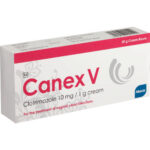Can I Pee After Using Clindamycin Cream?

Vaginal clindamycin cream is a medication used to treat bacterial vaginosis (an infection caused by an overgrowth of harmful bacteria in the vagina). Clindamycin is in a class of medications called lincomycin antibiotics. It works by slowing or stopping the growth of bacteria.
Bacterial vaginosis (BV) results from an imbalance in the numbers of beneficial and harmful bacteria in the vagina. It can cause vaginal itchiness, unusual discharge, and a characteristic odor, among other symptoms.
Vaginal clindamycin cream cannot be used to treat vaginal irritation caused by yeast infections or by sexually transmitted diseases such as chlamydia and trichomoniasis. Common brand names include: Cleocin, ClindaMax, Clindesse, and Dalatina.
Before using clindamycin cream
Some medicines are unsuitable for people with certain conditions, and sometimes a medicine may only be used if extra care is taken. For these reasons, before you start using clindamycin cream, it is important that your doctor knows:
• If you are pregnant or breastfeeding. (Although clindamycin is not known to be harmful to a baby, it is still important that you tell your doctor if you are expecting or breastfeeding a baby).
• If you have any bowel problems which cause you to have diarrhea.
• If you have ever had an allergic reaction to a medicine or a skin preparation.
• If you are taking any other medicines. This includes medicines you have bought without a prescription, as well as herbal and complementary medicines.
How to use clindamycin cream
• Before you start the treatment, read the manufacturer’s printed information leaflet from inside the pack. The manufacturer’s leaflet will give you more information about clindamycin, and it will also explain how to use the cream and applicator.
• Use clindamycin cream exactly as your doctor tells you to. It is for use in the vagina only.
• Use one applicatorful (approximately 5 grams) of cream in the vagina at bedtime. Your doctor will tell you how many days you should use the cream for – a course of treatment usually lasts for 3-7 consecutive days.
• If you forget to use the cream, use it as soon as you remember. If you do not remember until the following day, use the cream as normal for your next dose (do not ‘double up’ the amount of cream you use). Use the cream for the correct number of days in total.
How to fill the applicator and use the cream
1. Remove the cap from the tube of cream.
2. Attach one of the disposable applicators to the tube of cream (the applicator will screw onto the tube).
3. Squeeze the tube of cream gently to fill the applicator. When the plunger on the applicator stops moving, the applicator is full.
4. Unscrew the applicator from the tube, and replace the cap onto the tube.
5. Lie on your back and insert the applicator into your vagina. Insert it as far as is comfortable for you.
6. Gently push on the plunger of the applicator to empty the cream into your vagina. Then remove the applicator and throw it away (it can be wrapped in toilet paper and disposed of in a waste bin).
7. Wash your hands afterward.
One brand of vaginal cream (Clindesse®) is usually used as a single dose, given at any time of day. If you are using more than one dose of vaginal clindamycin, use it at around the same time every day. Follow the directions on your prescription label carefully, and ask your doctor or pharmacist to explain any part you do not understand. Use vaginal clindamycin exactly as directed. Do not use more or less of it or use it more often than prescribed by your doctor.
Use vaginal clindamycin until you finish the prescription, even if you feel better. If you stop using vaginal clindamycin too soon or skip doses, your infection may not be completely treated and the bacteria may become resistant to antibiotics.
How long does it take for clindamycin cream to work?
Once you start using clindamycin cream, you’ll likely notice an improvement in your symptoms in as little as a day or two. If your symptoms aren’t improving at all or seem to be getting worse after applying clindamycin cream for a few days, follow up with your healthcare provider.
Make sure to complete the prescribed course of treatment to reduce the likelihood of the infection returning. Always consult a health care provider for advice on how much and for how long to use the clindamycin cream.
If you experience any discomfort or side effects, make sure you inform your doctor or health care provider right away.
Can I pee after applying clindamycin vaginal cream?
Yes, you can pee after applying clindamycin vaginal cream for bacterial vaginosis because clindamycin cream is applied inside the vagina. There are two openings in the vulva — the vaginal opening and the opening to the urethra (the hole you pee out of). The urethral opening is the tiny hole you pee out of, located just below your clitoris. The vaginal opening is right below your urethral opening so urinating most time does not affect the effectiveness of clindamycin vaginal cream.
However, experts advise that you wait for at least 45 minutes to 1 hour after applying clindamycin vaginal cream before you urinate as peeing too early may result in the cream leaking out.
Nevertheless, if you feel pressed after applying clindamycin cream, use the bathroom immediately because holding your urine for too long can weaken the bladder muscles over time. This can lead to problems such as incontinence and not being able to fully empty your bladder. Holding your urine for extremely long periods of time can also cause urinary tract infections due to bacteria build-up.
Clindamycin cream is generally considered both safe and effective for treating bacterial vaginosis. In many cases, they may also provide faster and more targeted relief than oral medications, along with fewer side effects.
This medication is for vaginal use only. Do not swallow the cream and do not apply the cream to any other part of your body. Be careful not to get the cream in your eyes. If you do get the cream in your eyes, rinse your eyes with plenty of cool water.
Your medication will come with directions for use. Read these directions and follow them carefully. Ask your doctor or pharmacist if you have any questions about how to use vaginal clindamycin.
What should I watch for while using clindamycin cream?
Inform your healthcare team if your symptoms do not start to get better in a few days or if they get worse.
Do not have sex or use vaginal products like tampons or douches while using clindamycin vaginal cream and for a time after use. Having sex or using the cream can make it not work as well. Talk with your care team about how long to not have sex after the last dose.
This medication can damage and reduce the effect of latex-containing products such as condoms and diaphragms. Avoid the use of latex-containing products while using clindamycin vaginal cream and for 3 days after the last dose; throw away any products that are exposed to this medication.
Your clothing may get soiled. To help prevent reinfection, wear freshly washed cotton, not synthetic, underwear.
What are the possible side effects of clindamycin cream?
The most common side effects of clindamycin cream include:
- Mild skin rash
- Nausea
- Stomach pain
- Vaginal itching or discharge
- Vomiting
Get medical help right away, if you have any of the symptoms listed above.
Clindamycin cream may also cause serious side effects including:
- Changes in bowel habits
- Diarrhea that is watery or bloody
- Little or no urination
- Metallic taste in your mouth
- Severe stomach pain.
Get medical help right away, if you have any of the symptoms listed above.
These are not all the possible side effects of Clindamycin. For more information, ask your doctor or pharmacist.
Call your doctor for medical advice about side effects. You may report side effects to FDA at 1-800-FDA-1088.





